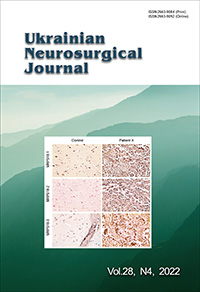Age aspect of neurophysiological diagnostics of post-concussion syndrome in patients with mild blast traumatic brain injury
DOI:
https://doi.org/10.25305/unj.260798Keywords:
mild blast traumatic brain injury, post-concussion syndrome, cognitive disorders, quantitative electroencephalographyAbstract
Introduction. It is generally accepted that age influences neuropsychological and neurophysiological findings due to a decrease in memory and attention in older age groups as a result of diseases and damage to the central nervous system of various origins. This should be taken into account when dealing with patients who underwent mild blast traumatic brain injury (mbTBI), and focus on standard characteristics considering the age factor.
Purpose: to investigate the influence of the age factor on the characteristics of cognitive evoked potentials in patients with post-concussion syndrome (PCS) in the long-term period of mbTBI.
Materials and methods. The study involved 41 patients with PCS aged 18-45 years (study group) and 30 healthy subjects (control group). The patients were in the late period of trauma (from 6 months to 3 years). The age distribution of patients in the study group was the following: 6 patients under 30 years old, 18 patients aged 31-40 years, 17 patients over 40 years old. Neuropsychological testing was performed according to the Montreal Cognitive Assessment Scale. Quantitative electroencephalography was performed according to standard parameters (sensitivity ‒ 70 μV/cm, time constant ‒ 0.1 s, filter ‒ 40 Hz).
The results. Neurophysiological testing using the CEP P300 method allows us to verify the dysfunction of brain activity in the form of attention and memory disorders in patients with PCS as a result of mbTBI in the chronic period of damage. Exceeding the upper limit of the age norm of P2 and P3 latency components of CEP P300 is statistically significantly associated with the presence of cognitive impairment in patients with PCS.
Conclusions. The CEP P300 method can be recommended for the use in the complex diagnostics of cognitive disorders in patients with PCS in the subacute and chronic periods of the injury. In the clinical interpretation of latency characteristics of CEP P300 components, it is reasonable to focus on standard parameters, including age factor.
References
Sirko A, Pilipenko G, Romanukha D, Skrypnik A. Mortality and Functional Outcome Predictors in Combat-Related Penetrating Brain Injury Treatment in a Specialty Civilian Medical Facility. Mil Med. 2020 Jun 8;185(5-6):e774-e780. doi: 10.1093/milmed/usz431
Zavaliy YV, Solonovych OS, Biloshitsky VV, Trеtiakova AI, Chebotariova LL, Suliy LM. Cognitive evoked potentials in the diagnosis of post-concussion syndrome due to blast mild traumatic brain injury. Ukrainian Neurosurgical Journal. 2021;27(4):3-9. doi: 10.25305/unj.236138
Gamage R, Wagnon I, Rossetti I, Childs R, Niedermayer G, Chesworth R, Gyengesi E. Cholinergic Modulation of Glial Function During Aging and Chronic Neuroinflammation. Front Cell Neurosci. 2020 Oct 15;14:577912. doi: 10.3389/fncel.2020.577912
Wood RL, Worthington A. Neurobehavioral Abnormalities Associated with Executive Dysfunction after Traumatic Brain Injury. Front Behav Neurosci. 2017 Oct 26;11:195. doi: 10.3389/fnbeh.2017.00195
Young JS, Hobbs JG, Bailes JE. The Impact of Traumatic Brain Injury on the Aging Brain. Curr Psychiatry Rep. 2016 Sep;18(9):81. doi: 10.1007/s11920-016-0719-9
Thompson JM, Scott KC, Dubinsky L. Battlefield brain: unexplained symptoms and blast-related mild traumatic brain injury. Can Fam Physician. 2008 Nov;54(11):1549-51.
Kropotov J. Quantitative EEG, event-related potentials and neurotherapy. Academic Press; 2010.
Helfrich RF, Knight RT. Cognitive neurophysiology: Event-related potentials. Handb Clin Neurol. 2019;160:543-558. doi: 10.1016/B978-0-444-64032-1.00036-9
Zavaliy YV. Neurological and neuropsychological characteristics of postconcussion syndrome following blast mild traumatic brain injury. Ukrainian Neurosurgical Journal. 2022;28(1):39-46. doi: 10.25305/unj.250714
Gnezditsky VV, Korepina OS, Chatskaya AV, Klochkova OI. [Memory, cognition and endogenous evoked potentials of the brain: assessment of cognitive impairment and working memory capacity without psychological testing]. Uspekhi fiziologicheskikh nauk. 2017;48(1):3-23. Russian.
de Tommaso M, Betti V, Bocci T, Bolognini N, et al. Pearls and pitfalls in brain functional analysis by event-related potentials: a narrative review by the Italian Psychophysiology and Cognitive Neuroscience Society on methodological limits and clinical reliability-part I. Neurol Sci. 2020 Oct;41(10):2711-2735. doi: 10.1007/s10072-020-04420-7
Downloads
Published
How to Cite
Issue
Section
License
Copyright (c) 2023 Lidia L. Chebotariova, Yurii V. Zavaliy

This work is licensed under a Creative Commons Attribution 4.0 International License.
Ukrainian Neurosurgical Journal abides by the CREATIVE COMMONS copyright rights and permissions for open access journals.
Authors, who are published in this Journal, agree to the following conditions:
1. The authors reserve the right to authorship of the work and pass the first publication right of this work to the Journal under the terms of Creative Commons Attribution License, which allows others to freely distribute the published research with the obligatory reference to the authors of the original work and the first publication of the work in this Journal.
2. The authors have the right to conclude separate supplement agreements that relate to non-exclusive work distribution in the form of which it has been published by the Journal (for example, to upload the work to the online storage of the Journal or publish it as part of a monograph), provided that the reference to the first publication of the work in this Journal is included.









